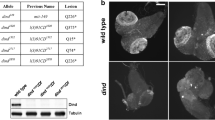Summary
A procedure for pole cell isolation has been developed that takes advantage of theDrosophila melanogaster maternal effect mutantmat(3) 1. Embryos derived from homozygousmat(3)1 mothers form exclusively pole cells. By outcrossing we could substantially increase the expressivity of the original mutant stock. We further introduced theTM8 balancer chromosome, which carries the dominant temperature sensitive mutationDTS-4. This allows the accumulation of large homozygousmat(3) 1 fly populations by eliminating the heterozygous flies at the restrictive temperature.
Early embryos were mechanically fragmented and the cells were isolated by means of metrizamide step gradients. The isolated cells were demonstrated to exhibit the various ultrastructural and histochemical characteristics of pole cells. The isolated cells were transplanted into genetically marked host embryos. The germ line mosaics that were obtained indicate that the isolated cells represent functional pole cells.
Proteins synthesized by the isolated pole cells during short term in vitro labelling with35S-methionine were compared to the proteins synthesized by blastoderm cells fromOregon-R embryos. At least one protein could be demonstrated in the pole cell samples that is not synthesized byOregon-R blastoderm cells.
The method allows a fast and gentle isolation of highly enriched pole cell populations which are a prerequisite for the biochemical analysis of germ cell determination and differentiation.
Similar content being viewed by others
References
Allis CD, Waring GL, Mahowald AP (1977) Mass isolation of pole cells fromDrosophila melanogaster. Dev Biol 56:372–381
Allis CD, Underwood EM, Caulton JH, Mahowald AP (1979) Pole cells ofDrosophila melanogaster in culture. Normal Metabolism, ultrastructure, and functional capabilities. Dev Biol 69:451–465
Bownes M (1975) A photographic study of development in the living embryo ofDrosophila melanogaster. J. Embryol Exp Morphol 33:789–801
Chan LN, Gehring WJ (1971) Determination of blastoderm cells inDrosophila melanogaster. Proc Natl Acad Sci (Wash) 68:2217–2221
Counce SJ (1963) Developmental morphology of polar granules inDrosophila including observations on pole cell behavior and distribution during embryogenesis. J Morphol 112:129–145
Deusen EB Van (1977b) Sex determination in germ line chimaeras ofDrosophila melanogaster. J Embryol Exp Morphol 37:173–185
Fielding CJ (1967) Developmental genetics of the mutantgrandchildless ofDrosophila subobscura. J Embryol Exp Morphol 17:375–384
Gehring WJ (1976) Determination. In: Allfrey VG, Bautz EKF, McCarthy BJ, Schimke RT, Tissières A (eds) Organization and expression of chromosomes, life sciences research report 4, Dahelm Konferenzen, Berlin, pp 97–113
Gutzeit HO, Gehring WJ (1979) Localized Synthesis of specific proteins during oogenesis and early embryogenesis inDrosophila melanogaster. Wilhelm Roux' Archiv Entwicklungsmech Org 187:151–165
Hegner RW (1914) The germ cell cycle in animals. McMillan Company, New York, 346 pp
Illmensee K (1973) The potentialities of transplanted early gastrula nuclei ofDrosophila melanogaster. Production of their imago descendants by germ-line transplantation. Wilhelm Roux' Arch Entwicklungsmech Org 171:331–343
Illmensee K (1978)Drosophila chimeras and the problem of determination. In: Gehring WJ (ed) Results and problems in cell differentiation, vol 9, genetic mosaics and cell differentiation. Springer, Berlin, Heidelberg, New York, pp 51–70
Laskey RA, Mills AD (1975) Quantitative film detection of3H and14C in Polyacrylamide Gels by Fluorography. Eur J Biochem 56:335–341
Laemmli UK (1970) Cleavage of Structural proteins during the assembly of the head of bacteriophage T4. Nature 227:680–685
Mahowald AP (1968) Polar granules ofDrosophila. II. Ultrastructural changes during early embryogenesis. J Exp Zool 167:237–262
Mahowald AP (1971) Origin and continuity of polar granules. In: Reinert J, Ursprung H (ed) Results and problems in cell differentiation vol 2. Springer, Berlin, Heidelberg, New York, pp 158–169
Mahowald AP, Allis CD, Karrer KM, Unterwood EM, Waring GL (1979) Germ plasm and pole cells ofDrosophila. In: Konigsberg IR, Subtelny S (eds) Determinants of spatial Organisation. 37th Symposium of the Society for Developmental Biology, Academic Press, New York, pp 127–146
Marsh JL (1978) Construction of a third chromosome balancer bearing a dominant temperature sensitive lethal. Dros Inf Service 53:155–156
O'Farrell PH (1975) High resolution two-dimensional electrophoresis of proteins. J Biol Chem 250:4007–4021
Pearse AGE (1968) Histochemistry, vol I, 3rd edn. Churchill, Livingstone, p 601
Poulson DF, Waterhouse DF (1960) Experimental studies on pole cells and midgut differentiation inDiptera. Aust J Biol Sci 13:541–566
Rabiowitz M (1941) Studies on the cytology and early embryology of the egg ofDrosophila melanogaster. J Morphol 69:1–49
Regenass U (1979) Isolation of pole cells and auxotrophic cell lines fromDrosophila melanogaster maternal effect mutants. Ph. D. Thesis, University Basel
Regenass U, Bernhard HP (1978) Analysis of theDrosophila maternal effect mutantmat(3) 1 by pole cell transplantation experiments. Molec Gen Genet 164:85–91
Regenass U, Bernhard HP (1979)Rudimentary mutants ofDrosophila melanogaster: Isolation and characterisation of pyrimidine auxotrophic cell lines. Wilhelm Roux' Arch Entwicklungsmech Org 187:167–177
Rice TB, Garen A (1975) Localized defects of blastoderm formation in maternal effect mutants ofDrosophila. Dev Biol 43:277–286
Romeis B (1968) Mikroskopische Technik, 16. Auflage. R. Oldembourg, München, Wien, p 259
Schüpbach T, Wieschaus E, Nöthiger R (1978) A study of the female germ line in mosaics ofDrosophila. Wilhelm Roux' Arch Entwicklungsmech Org 184:41–56
Shields G, Sang HJ (1977) Improved medium for culture ofDrosophila embryonic cells. Dros Inf Service 52:161
Sonnenblick BP (1950) In: Demerec M (ed) Biology ofDrosophila. John Wiley & Sons, New York, pp 62–167
Underwood E, Caulton J, Allis D, Mahowald AP (1979) Do pole cells have multiple developmental fates? 6th EuropeanDrosophila Research Conference, Kupari, Yugoslavia 1979 (Abstract)
Waring, GL, Allis CD, Mahowald AP (1978) Isolation of polar granules and the identification of polar granule specific protein. Dev Biol 66:197–206
Wieschaus E, Szabad J (1979) The development and function of the female germ line inDrosophila melanogaster: a cell lineage study. Dev Biol 68:29–46
Author information
Authors and Affiliations
Rights and permissions
About this article
Cite this article
Regenass, U., Bernhard, H.P. The isolation of functional pole cells from theDrosophila melanogaster maternal effect mutantmat(3)1 . Wilhelm Roux' Archiv 188, 127–132 (1980). https://doi.org/10.1007/BF00848804
Received:
Accepted:
Issue Date:
DOI: https://doi.org/10.1007/BF00848804




